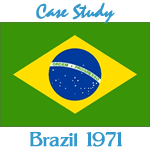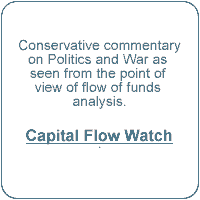 Case Study: 1971 Bubble in Brazilian Stock Market
Case Study: 1971 Bubble in Brazilian Stock Market
Case Study
The Bubble in Brazilian Equities: 1971
Flow of funds analysis can be used even in emerging markets that do not have national flow of funds accounting.
Here is a example of Capital Flow Analysis employed by the author in 1971, years before current methods and axioms were developed.
The Brazilian equity market in 1971 presented an unusual opportunity to observe capital flows, since the market at that time was virtually a closed system.
In the 1960s, the Brazilian equity market was virtually a closed system
For practical purposes, in 1971, fund flows from abroad into Brazilian equities were insignificant. The stock market was new, simple, and with relatively few participants.
The flows that drove the boom and bust of 1971 can now be seen in retrospect as the obvious and easily understood causes of price trends.
However, most players in the Brazilian market in the first half of 1971 did not perceive the forces of supply and demand behind the stock market bubble, nor the inevitable triggers that would cause the market to reverse course in six months and fall for almost a decade.
The crash occurred during the peak of the Brazilian Economic Miracle in a year of economic prosperity and reform.
As is the case with most bubbles, these were good times.
The Sociopolitical Environment
Brazilian Politics in the 1960s
To understand the Brazilian stock market bubble of 1971, we must try to see events through the eyes of players in that year.
For this, we need to review the sociopolitical background of the Economic Miracle — a paradigm shift that transformed Latin America's largest country from an agricultural society into an industrial power in fifteen years.
An account of events leading up to the Revolution of 1964 can be found in Skidmore's 'Politics in Brazil', published in 1967 and financed by Harvard University, years before today's revisionist histories.
The forces that drove the stock market boom of 1971, were part of an extraordinary political and economic environment — the very best of years in which prosperity and comparative civil order reigned.
In 1971, few people imagined that within a decade the disciplined government responsible for the 'Miracle' would voluntarily relinquish power, inviting demagogues to regain control, allowing Latin America's most prosperous nation to sink into despair and the worst political and economic turmoil of the century.
America's Friend in South America
In the 1960s, the United States was deeply engaged in a Cold War with Soviet Russia. In the prior decade, the Americans had fought a bloody war with the communists in Korea, sacrificing 33,000 U.S. lives in combat (1950-1953).
These were scary times. There was atmospheric testing of hydrogen bombs. Policies of mutual assured destruction between the United States and the Soviet Union kept the peace.
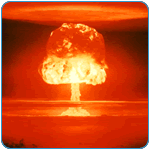 In the 1960s, the atomic bomb was on every mind
In the 1960s, the atomic bomb was on every mindIn Asia, the war against communism evolved into a bloody conflict in Vietnam, which took over a million lives.
Elsewhere, half of Europe was imprisoned behind an iron curtain, living dismal lives as serfs of the Soviets.
In Latin America, the fight against Soviet influence raged in a dozen countries.
In Cuba, Soviets ignored the Monroe Doctrine and gained a foothold in the hemisphere through the communist dictator, Fidel Castro, who went on to promote civil disorder and sedition in a dozen countries throughout the hemisphere.
Brazil, the largest nation in Latin America, had been a friend of the United States since World War II, when the 23,000 man Brazilian Expeditionary Force fought along with Americans, notably in the Battles of Monte Cassino, Montese, and Fornovo in Italy, in which 400 Brazilians lost their lives and 15,000 of the enemy were captured.
The close ties with the United States continued into the Cold War.
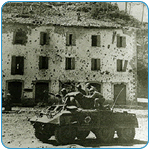 Brazilian soldiers fighting along with Americans in WW II
Brazilian soldiers fighting along with Americans in WW IIUnder President Kennedy, after the defeat at the Bay of Pigs, the U.S. sought to contain Fidel Castro's attempts to export communism by implementing policies with respect to the Brazilian military that were consistent with goals of the Alliance for Progress.
U.S. training assistance for the Brazilian army stressed counterinsurgency tactics and civic action against communist infiltration.
Since 1946, the U.S. government trained Brazilians to fight urban guerillas at the School of the Americas in the Panama Canal Zone.
Highlights of the 1950s and 1960s
From 1955 to 1961, Juscelino Kubitschek (1902-1976), the democratically elected president of the Brazil, pushed economic development, particularly in energy, transportation, and the building of the new capital, Brasilia.
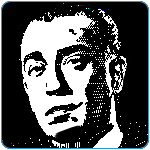 Juscelino Kubitschek laid the foundations for the Brazilian Miracle
Juscelino Kubitschek laid the foundations for the Brazilian MiracleKubitschek's slogan was 'Fifty years of progress in five'.
During his term, development of the Brazilian automobile industry began in ernest, along with measures to develop the securities market undertaken by José Garrido Torres, the head of SUMOC.
Presidential terms in Brazil were limited to five years and Juscelino Kubitschek was followed by another democratically elected president, Jânio Quadros (1917-1992), who had been governor of the State of São Paulo.
Jânio Quadros was initially viewed as an attractive figure who promised to fight bureaucracy. His election was met with optimism.
His popular symbol was a broom, suggesting a clean sweep of the corruption that had long dominated the democratic process.
However, once in office, Jânio Quadros began to exhibit strange and bizarre behavior that upset the centrist, middle-class base that had elected him.
Some thought he lacked the commitment to capitalism on which economic progress depended.
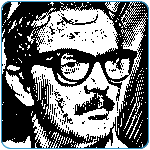 'Terrible Forces' drove Jânio Quadros from office.
'Terrible Forces' drove Jânio Quadros from office.He was secretive, erratic, ambiguous, and even weird.
Jânio Quadros failed to reward with government positions the people who had supported him.
He blindly followed IMF recommendations for austerity and removed price controls, quickly losing popular support as the price of wheat and oil doubled.
He governed by issuing 'little notes' and capricious orders prohibiting bikinis on Rio beaches and the use of perfume sprays during Carnival. He designed a strange uniform for public employees.
Between election and inauguration, rather than choosing a cabinet, he traveled abroad, adopting a quixotic policy towards the communist world.
He instigated investigations against corruption by politicians of all stripes, including his own Vice President, João Goulart.
In 1961, after only seven months in office, having lost support on all sides, Jânio Quadros suddenly resigned, citing 'terrible forces'.
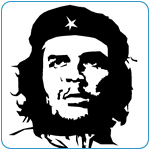 Many did not understand why Jânio Quadros honored Che Guevara at the height of the Cold War
Many did not understand why Jânio Quadros honored Che Guevara at the height of the Cold WarHe left the country, after pinning Brazil's highest award for foreigners on the chest of Ernesto 'Che' Guevara (1928-1967), the communist 'el comandante' of Fidel Castro's dictatorship.
Jânio Quadros never explained the 'terrible forces' that made him resign.
Undoubtedly, these forces were nothing more sinister than the loss of support from the political groups that had brought him to power and his unwillingness to compromise, as required by the democratic process.
Under Brazilian law at the time, the Vice President was the candidate for President who received the second highest number of votes, which meant that the Vice President might be from a different political party.
When Jânio Quadros resigned, Vice President João Goulart (1918-1976), was touring Communist China with Brazilian labor leaders.
